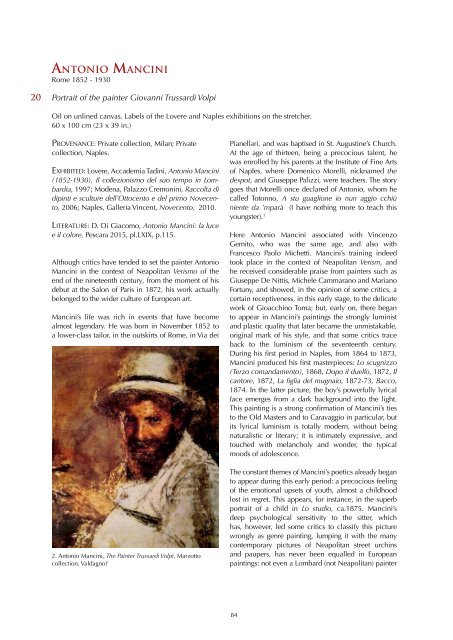You also want an ePaper? Increase the reach of your titles
YUMPU automatically turns print PDFs into web optimized ePapers that Google loves.
Antonio Mancini<br />
Rome 1852 - 1930<br />
20<br />
Portrait of the painter Giovanni Trussardi Volpi<br />
Oil on unlined canvas. Labels of the Lovere and Naples exhibitions on the stretcher.<br />
60 x 100 cm (23 x 39 in.)<br />
Provenance: Private collection, Milan; Private<br />
collection, Naples.<br />
Exhibited: Lovere, Accademia Tadini, Antonio Mancini<br />
(1852-1930), Il collezionismo del suo tempo in Lombardia,<br />
1997; Modena, Palazzo Cremonini, Raccolta di<br />
dipinti e sculture dell’Ottocento e del primo Novecento,<br />
2006; Naples, Galleria Vincent, Novecento, 2010.<br />
Literature: D. Di Giacomo, Antonio Mancini: la luce<br />
e il colore, Pescara 2015, pl.LXIX, p.115.<br />
Although critics have tended to set the painter Antonio<br />
Mancini in the context of Neapolitan Verismo of the<br />
end of the nineteenth century, from the moment of his<br />
debut at the Salon of Paris in 1872, his work actually<br />
belonged to the wider culture of European art.<br />
Mancini’s life was rich in events that have become<br />
almost legendary. He was born in November 1852 to<br />
a lower-class tailor, in the outskirts of Rome, in Via dei<br />
2. Antonio Mancini, The Painter Trussardi Volpi, Marzotto<br />
collection, Valdagno?<br />
Pianellari, and was baptised in St. Augustine’s Church.<br />
At the age of thirteen, being a precocious talent, he<br />
was enrolled by his parents at the Institute of Fine Arts<br />
of Naples, where Domenico Morelli, nicknamed the<br />
despot, and Giuseppe Palizzi, were teachers. The story<br />
goes that Morelli once declared of Antonio, whom he<br />
called Totonno, A stu guaglione io nun aggio cchiù<br />
niente da ’mparà (I have nothing more to teach this<br />
youngster). 1<br />
Here Antonio Mancini associated with Vincenzo<br />
Gemito, who was the same age, and also with<br />
Francesco Paolo Michetti. Mancini’s training indeed<br />
took place in the context of Neapolitan Verism, and<br />
he received considerable praise from painters such as<br />
Giuseppe De Nittis, Michele Cammarano and Mariano<br />
Fortuny, and showed, in the opinion of some critics, a<br />
certain receptiveness, in this early stage, to the delicate<br />
work of Gioacchino Toma; but, early on, there began<br />
to appear in Mancini’s paintings the strongly luminist<br />
and plastic quality that later became the unmistakable,<br />
original mark of his style, and that some critics trace<br />
back to the luminism of the seventeenth century.<br />
During his first period in Naples, from 1864 to 1873,<br />
Mancini produced his first masterpieces: Lo scugnizzo<br />
(Terzo comandamento), 1868, Dopo il duello, 1872, Il<br />
cantore, 1872, La figlia del mugnaio, 1872-73, Bacco,<br />
1874. In the latter picture, the boy’s powerfully lyrical<br />
face emerges from a dark background into the light.<br />
This painting is a strong confirmation of Mancini’s ties<br />
to the Old Masters and to Caravaggio in particular, but<br />
its lyrical luminism is totally modern, without being<br />
naturalistic or literary; it is intimately expressive, and<br />
touched with melancholy and wonder, the typical<br />
moods of adolescence.<br />
The constant themes of Mancini’s poetics already began<br />
to appear during this early period: a precocious feeling<br />
of the emotional upsets of youth, almost a childhood<br />
lost in regret. This appears, for instance, in the superb<br />
portrait of a child in Lo studio, ca.1875. Mancini’s<br />
deep psychological sensitivity to the sitter, which<br />
has, however, led some critics to classify this picture<br />
wrongly as genre painting, lumping it with the many<br />
contemporary pictures of Neapolitan street urchins<br />
and paupers, has never been equalled in European<br />
paintings: not even a Lombard (not Neapolitan) painter<br />
84
















